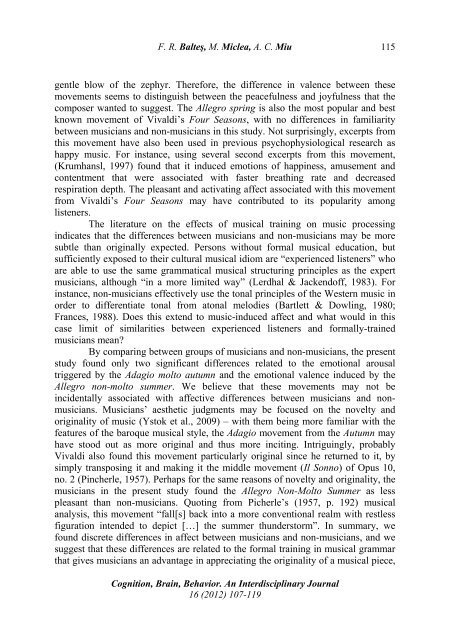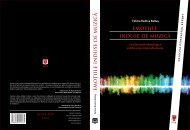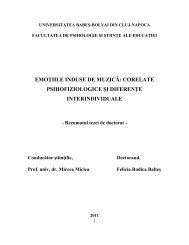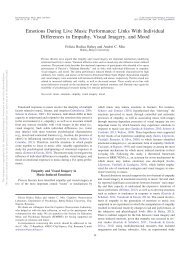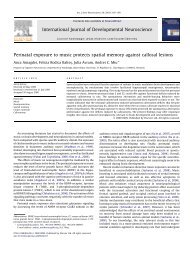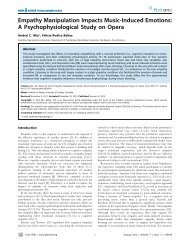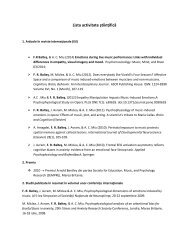o_19k6fnuqsqg41mt7rqp1c8pkueo.pdf
Create successful ePaper yourself
Turn your PDF publications into a flip-book with our unique Google optimized e-Paper software.
F. R. Balteş, M. Miclea, A. C. Miu<br />
115<br />
gentle blow of the zephyr. Therefore, the difference in valence between these<br />
movements seems to distinguish between the peacefulness and joyfulness that the<br />
composer wanted to suggest. The Allegro spring is also the most popular and best<br />
known movement of Vivaldi’s Four Seasons, with no differences in familiarity<br />
between musicians and non-musicians in this study. Not surprisingly, excerpts from<br />
this movement have also been used in previous psychophysiological research as<br />
happy music. For instance, using several second excerpts from this movement,<br />
(Krumhansl, 1997) found that it induced emotions of happiness, amusement and<br />
contentment that were associated with faster breathing rate and decreased<br />
respiration depth. The pleasant and activating affect associated with this movement<br />
from Vivaldi’s Four Seasons may have contributed to its popularity among<br />
listeners.<br />
The literature on the effects of musical training on music processing<br />
indicates that the differences between musicians and non-musicians may be more<br />
subtle than originally expected. Persons without formal musical education, but<br />
sufficiently exposed to their cultural musical idiom are “experienced listeners” who<br />
are able to use the same grammatical musical structuring principles as the expert<br />
musicians, although “in a more limited way” (Lerdhal & Jackendoff, 1983). For<br />
instance, non-musicians effectively use the tonal principles of the Western music in<br />
order to differentiate tonal from atonal melodies (Bartlett & Dowling, 1980;<br />
Frances, 1988). Does this extend to music-induced affect and what would in this<br />
case limit of similarities between experienced listeners and formally-trained<br />
musicians mean?<br />
By comparing between groups of musicians and non-musicians, the present<br />
study found only two significant differences related to the emotional arousal<br />
triggered by the Adagio molto autumn and the emotional valence induced by the<br />
Allegro non-molto summer. We believe that these movements may not be<br />
incidentally associated with affective differences between musicians and nonmusicians.<br />
Musicians’ aesthetic judgments may be focused on the novelty and<br />
originality of music (Ystok et al., 2009) – with them being more familiar with the<br />
features of the baroque musical style, the Adagio movement from the Autumn may<br />
have stood out as more original and thus more inciting. Intriguingly, probably<br />
Vivaldi also found this movement particularly original since he returned to it, by<br />
simply transposing it and making it the middle movement (Il Sonno) of Opus 10,<br />
no. 2 (Pincherle, 1957). Perhaps for the same reasons of novelty and originality, the<br />
musicians in the present study found the Allegro Non-Molto Summer as less<br />
pleasant than non-musicians. Quoting from Picherle’s (1957, p. 192) musical<br />
analysis, this movement “fall[s] back into a more conventional realm with restless<br />
figuration intended to depict […] the summer thunderstorm”. In summary, we<br />
found discrete differences in affect between musicians and non-musicians, and we<br />
suggest that these differences are related to the formal training in musical grammar<br />
that gives musicians an advantage in appreciating the originality of a musical piece,<br />
Cognition, Brain, Behavior. An Interdisciplinary Journal<br />
16 (2012) 107-119


